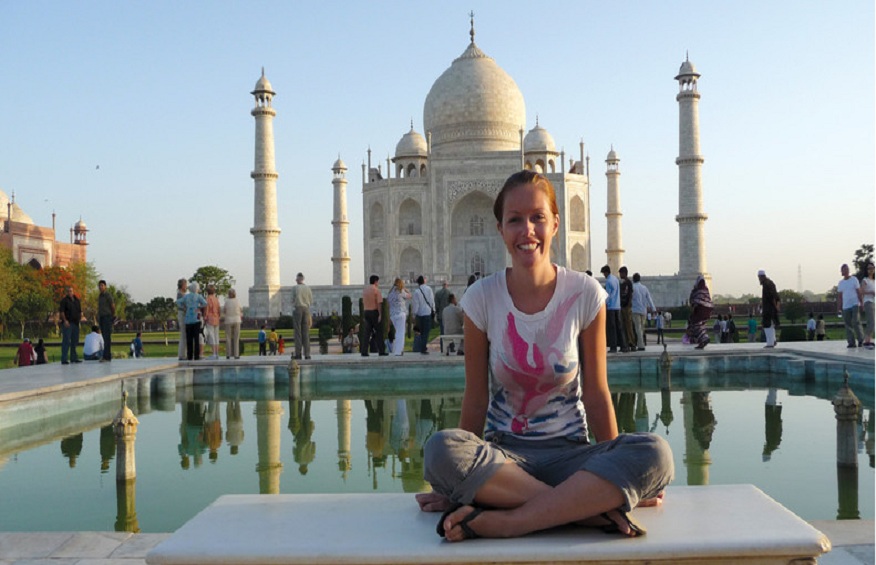If it were to have an 8th Wonder of the World , the Taj Mahal would surely be on the list of contenders. Its gigantic proportions, its light, its beauty, its forms, this luminous white, its precious stones, the whole edifice carries within it something royal, sublime.
But what do you really know what the Taj Mahal is? Why was it built and for whom?
Located on the right bank of the Yamuna River, in the center of a gigantic Mughal garden of almost 17 hectares, very close to the city of Agra in India, the Taj Mahal is today an emblematic monument, made of marble finely chopped white. It is considered the finest architectural gem of Indo-Islamic art. So many reasons to finally visit this famous monument! We explain here how to get to Agra from New Delhi , and how to visit the Taj Mahal once there.
The Taj Mahal on a winter morning
It is before for its incredible architecture that the Taj Mahal attracts up to 4 million visitors each year, which makes it the most visited monument in India. The Taj Mahal for the Indians is a real symbol like the Eiffel Tower for France, the Statue of Liberty in the United States or Christ the Redeemer in Brazil.
Indeed, this complex architecture is based on a combination of solids and voids, on elements that are both concave and convex but also on a skilfully orchestrated play of light. The dazzling green flowerbeds line the paths with reddish hues while the whole is shimmering white, ultra-bright contrasting with the sky of such pure blue.
And what about the marble sculptures with the inlays of precious and semi-precious stones which offer a whole new singularity to this originally religious building!
The construction of the Taj Mahal began in 1632 and ended in 1648. It was the Mughal emperor Shah Jahan who decided to erect a monument in memory of his third wife, Mumtaz Mahal, who died at the age of 40 in childbirth while that she gave birth to their 14th child after 30 hours of work.
If the mausoleum is the best known place of the Taj Mahal, we must not however reduce this building to this single room. Indeed, the Taj Mahal is a set of buildings, gardens, fountains and other bodies of water whose symmetry has been meticulously worked out, all on a plot of 305 by 580 meters. The mosque, the main entrance and the guest pavilion as well as the outer courtyard were added in 1653. There are also two mosques.
It is behind the entrance patio, surrounded by arcades that the Taj Mahal truly offers a magical vision of all its splendor: when you look to the south, you will see a garden divided into 4 equal parts with marble terraces and a fountain in its center.
If you look towards the North, the mausoleum and the annexes are offered to your eyes over the entire width of the garden. Finally, on the west side stands out another mosque and to the east you will find a meeting hall.
It is a gigantic construction of disproportionate proportions: it is said that 22,000 people worked on its construction for 22 years for a budget of 32 million Indian rupees. More than 28 types of semi-precious and precious stones are embedded in the walls of the Taj Mahal. Its beauty remains unmatched to Indians so the builders of the Taj Mahal had their hands and eyes cut out never to work on anything more majestic. There is a replica of the Taj Mahal in Bangladesh, designed by a filmmaker in 2008.
The building is designed with architectural perfection and incredible symmetry: the 4 sides of the Taj Mahal are identical in order to give the impression of a reflection as if it were a mirror. The Taj Mahal is visited especially in the morning, at dawn (before 7 a.m.) to take advantage of a particular light (and avoid mass tourists). It is a place reserved for Muslims on Fridays: the Taj Mahal is not a Hindu building, it also contains two mosques. It is therefore closed on Fridays.
The building is the subject of a strong protection policy, in particular vis-à-vis motor vehicles which would pollute the walls and the gardens. Emperor Shah Jahan, initiator of the Taj Mahal project for his late wife, was imprisoned by his son, Aurangzeb and spent his final years observing the construction of the Taj Mahal from across the Yamuna River before joining his wife at her dead. It is possible to trace the entire chronology of the Taj Mahal through the various Quranic and historical inscriptions written in Arabic. Masons, sculptors, marble workers, painters, calligraphers, mosaicists and other builders have definitely left an indelible mark by developing such a sumptuous building.
To book your flight to India at the best price, read our tips for booking a cheap flight online before using an online comparator like Skyscanner for example. The flight time is about 8 hours for a Paris-Delhi. The price of a flight is around €500 return.
Be careful, you must nevertheless make this reservation a few days in advance because the trains – a very popular means of transport – are quickly crowded. You have to go to New Delhi station (NDLS) and the train will arrive at Agra Cantt station (AGC). Travel time is 3 hours from New Delhi. Note that the trains to Agra are the Taj Express and the Bhopal Shatabdi Express. Expect delays. To book a train online, we advise you to read the advice of this blog which details how to book a train ticket in India.

